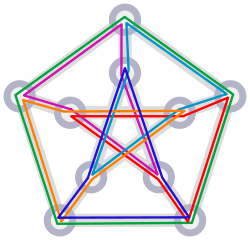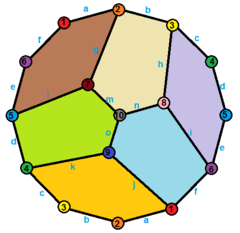Hemi-dodecahedron
| Hemi-dodecahedron | |
|---|---|
|
decagonal schlegel diagram | |
| Type |
abstract regular polyhedron globally projective polyhedron |
| Faces | 6 pentagons |
| Edges | 15 |
| Vertices | 10 |
| Vertex configuration | 5.5.5 |
| Schläfli symbol | {5,3}/2 or {5,3}5 |
| Symmetry group | A5, order 60 |
| Dual polyhedron | hemi-icosahedron |
| Properties |
non-orientable Euler characteristic 1 |
A hemi-dodecahedron is an abstract regular polyhedron, containing half the faces of a regular dodecahedron. It can be realized as a projective polyhedron (a tessellation of the real projective plane by 6 pentagons), which can be visualized by constructing the projective plane as a hemisphere where opposite points along the boundary are connected and dividing the hemisphere into three equal parts.
It has 6 pentagonal faces, 15 edges, and 10 vertices.
It can be projected symmetrically inside of a 10-sided or 12-sided perimeter:
Petersen graph
From the point of view of graph theory this is an embedding of Petersen graph on a real projective plane. With this embedding, the dual graph is K6 (the complete graph with 6 vertices) --- see hemi-icosahedron.

The six faces of the hemi-dodecahedron depicted as colored cycles in the Petersen graph
See also
- 57-cell – an abstract regular 4-polytope constructed from 57 hemi-dodecahedra.
- hemi-icosahedron
- hemi-cube
- hemi-octahedron
References
- McMullen, Peter; Schulte, Egon (December 2002), "6C. Projective Regular Polytopes", Abstract Regular Polytopes (1st ed.), Cambridge University Press, pp. 162–165, ISBN 0-521-81496-0
External links
This article is issued from Wikipedia - version of the 10/22/2016. The text is available under the Creative Commons Attribution/Share Alike but additional terms may apply for the media files.
